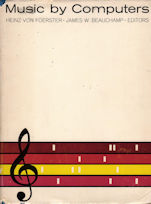It is at this point, where the complexity of the problem appears to go out of hand, that computers come to our aid. These are not to be regarded merely as ancillary tools but as essential components in the complex process of generating auditory signals that fulfill a variety of new principles of a generalized aesthetics.
This important new book—the only one of its kind presently available—focuses on three aspects in the use of computers in generating music.
First, computer hardware and software for implementing the generation of sounds are discussed under the heading Systems and Programs. Second, the versatility of digital computers in exploring rules of succession and synchronism is demonstrated in the section, Composition. Finally, the problem of judgment entering perception—i.e., what is “beautiful” and what is “ugly” or, to put it into information theoretical terms: what distinguishes signal from noise is taken up in the section, Aesthetics.
At the end of the book, the reader may turn into a listener. A pocket of the back cover contains four high fidelity records of all the examples mentioned in the text which allow the testing of the presented theories to skeptics and enthusiasts alike.
